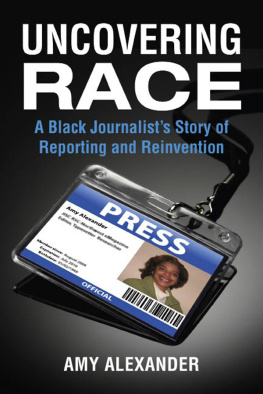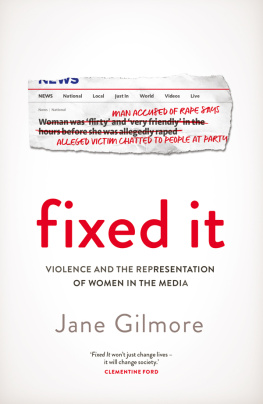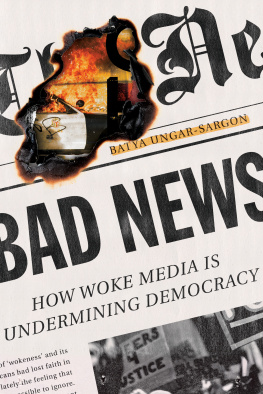Acknowledgments
This book would not have been possible without all of the brave and brilliant women who have made journalism a better profession. Nearly one hundred of them spoke to us for this book, willingly sharing both their successes and their mistakes and talking movingly about what its like to lead as a woman. They, as well as the more than a dozen men we interviewed, are listed at the end of this book, and we are forever grateful to them for their generosity.
A special thanks to Jill Abramson, Monika Bauerlein, Melissa Bell, Clara Jeffery, Wanda Lloyd, Marcy McGinnis, Mi-Ai Parrish, and Sandy Rowe for spending hours and hours with us and welcoming us into their workplaces, their homes, and their lives.
We want to thank our amazing colleagues at the Walter Cronkite School of Journalism and Mass Communication at Arizona State University. Dean Christopher Callahan has been supportive every step of the way, encouraging us to pursue this idea, giving us the time to do it, reading chapters, and helping in numerous other ways. He is an inspirational leader, and we feel fortunate that he is in our lives. Many other Cronkite colleagues contributed editing, brainstorming, encouragement, and their creative talents. They include Rebecca Blatt, Monica Chadha, Sarah Cohen, Linda Davis, Leonard Downie Jr., Christia Gibbons, Venita Hawthorne James, Mi-Ai Parrish, Fernanda Santos, Jean Sheeley, Amy Silverman, Terry Greene Sterling, and John West.
We also are grateful to friends and family members who connected us to key people and who provided support and editing help throughout the process. Thanks especially to Dana and Brandon Bauer, Brenda Campbell, Caroline Campbell Rogers, Don Campbell, Eden Campbell, Emmaline Campbell, Gary Gilger, Patrick Gilger, Karen Kurtz, Alex Novet, Lauren and Jesse Teer, Charles Wallace, and Rob Yarin.
As we worked, we kept in mind the many wonderful students at the Cronkite School and how women of our generation might help them as they begin to craft their futures. We asked several students and recent alumni for their feedback and their help with fact-checking and copy editing. Grace Clark, Yael Grauer, Ashley Mackey, Adrienne St. Clair, and Rebekah Zemansky all give us hope for the future.
This book would not have been possible without the support of Elizabeth Swayze at Rowman & Littlefield. From the beginning, she understood our vision and believed in it. Her guidance, and that of Megan Manzano, made writing a book almost fun.
Both of us have benefited from strong female leaders who have guided our careers. For Julia, those mentors include Sandy Rowe, her first female editor; Amy Eisman, who encouraged her to think beyond her wildest dreams; Nancy Monaghan, who gave her a much-needed kick in the pants when it counted; Karen Jurgensen, who taught her about servant leadership; Sara Bentley, who gave her a chance when she most needed it; and Pam Johnson, who was a visionary leader decades ahead of her time.
It was Sister John Marie who first convinced Kristin, back in the sixth grade, that a girl could lead. Years later, at the University of Nebraska, Wilma Crumley proved it through her own quiet example. Joanne Heisler showed Kristin that kindness and leadership are not opposites, and Mary Schier taught her that words matter. And then there was Julia, who walked into the Statesman Journal newspaper in Oregon and turned the place upside downin a good wayand later brought her to Phoenix so they could work together again.
There are men who have made a difference to us as well. Sometimes they acted as linemen, blocking the worst blows, and sometimes they offered quiet support that boosted our confidence.
For Julia, they include Ron Martin, who always gave great advice that she didnt listen to often enough; Mark Nadler, who guided her through her first big job as an editor; John Oppedahl, who taught her the importance of bravery; Doug Franklin and Jay Smith, who supported her through difficult times; James Mallory, who was an amazing partner and ally; Jim Kennedy, who defended her work at the Atlanta Journal-Constitution in ways she wasnt even aware of at the time; and Alex Taylor, who demonstrated the incredible power of humility.
Kristin has had the great gift of working for two of journalisms most inspirational leaders: Jim Amoss, who led the Times-Picayune, in New Orleans, through the papers most formative and most trying years; and Christopher Callahan, who truly possesses superhuman powers of energy and understanding that have buoyed her for the past fifteen years.
We also want to thank our husbands for their support during the writing of this book. They barely complained about the late nights, lost weekends, and endless conversations about the perfect title.
To Don: Ever since that fried chicken picnic, you have been that rock of support, that voice in my head. On this project, as on every one before, you gave me room to be me but knew when to step in when me needed a bit of moderating and editing.
To Gary: You are the one person I know who never equivocates, who never holds back. Even when you dont understand what Im doing or why, youre all in. Thats what makes a marriage work, and its not a bad foundation for a career either.
1
Too Wimpy or Too Bitchy? Finding an Effective Way to Lead
One of the things Ive learned the hard way is that you actually have to lead by being who you really are. And you cant fake who you are.
Margaret Low
Cynthia Hudson, the head of CNN en Espaol, describes herself as having Cuban passion in my bloodstream. She realized that when she got excited about something, she could come across as loud and angry. Hudson learned to temper her delivery to her audience. Im not abrasive, she said, but sometimes my style comes across as dominant, so I pull back.
*
During her long career, Susan Lyne ran the entertainment division of ABC, managed Martha Stewarts empire while Stewart was in prison, and served as CEO of the company that spawned Gilt, an enormously popular online shopping website. She learned to navigate all-male corporate hierarchies by being the best-prepared person in the room. She not only mastered whatever issue was up for discussion but she also became a student of those around her. You have to understand who could cause trouble for you, who your natural allies are, and how you can get what you need, she said.
*
Jessica Lessin founded a technology news company, The Information, after a successful career covering technology at the Wall Street Journal. Leading her own staff, she discovered, meant that she was visible in a way she never had been before. If she was having a bad day in the office, everyone else ended up having a bad day too. She now tries to be careful about the impression she makes. I tend to show how Im feeling, and thats not a great trait in a manager, she said. I want to make sure that Im communicating what I want deliberately rather than just reacting to the moment.
*
Kim Guthrie, president of Cox Media Group, can drink, swear, and go toe-to-toe with almost anyone. Shes blunt and outgoing, and she effortlessly dominates a room. Im authentic, she said. But sometimes my big mouth gets me into trouble. While she was comfortable with her style, Guthrie knew she wasnt exactly winning people over, so she decided to make a deliberate effort to lead from the back of the boat. Leadership, she said, is a little like running for officeyou have to focus on your people and win them over one by one.
* * *
Every one of these women rose to top leadership positions in a news organization before they had really figured out what kind of leader they wereor what kind of leader they wanted to be. Some, by instinct or personality, were collegial, accommodating, bossy, motherly, outgoing, reserved, or a mix of comparable traits. They quickly learned that they could be some of these things some of the time but none of these things all of the time. They found themselves running up against their companys and societys expectations of what a female leader looks like and acts like.




